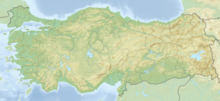Tanır rock inscription
Coordinates: 38 ° 25 '16.3 " N , 36 ° 55' 10.1" E
The rock inscription from Tanır in southern Turkey is written in Luwian hieroglyphics and dates from the time of the late Hittite states . It is assigned to the Kingdom of Melid and is believed to have been in the 9th or 8th century BC. BC originated.
Location and discovery
The inscription is located in the area called Yukarı Boğazı (upper gorge) in the village of Tanır in the Afşin district of the Turkish province of Kahramanmaraş , near a source called Sahren . It is engraved at a height of 2.70 meters on a vertical rock wall above the western bank of the Hurman Çayı River. The surface of the inscription is smoothed and surrounded by a rounded frame that is difficult to recognize. High above the inscription, the rock face has an eight meter wide niche, 0.90 meters deep and 0.70 meters high, which is dated to Roman times.
Even if the position of the inscription is today in the province of Kahramanmaraş, which corresponds to the late Hittite Gurgum , it is known from numerous finds that the plain of Elbistan belonged to the kingdom of Melid in the epoch in question , the center of which was today's Malatya . The river Hurman, with the road following its course, represented an important traffic connection to the north and west to Kummani over the mountain ranges of the Dibek and the Binboğa Dağları . The Hittite settlement hills Yassıhöyük and Elbistan-Karahöyük are nearby .
The inscription was discovered on August 18, 2009 by the Turkish archaeologist Erkan Konyar from Istanbul Üniversitesi as part of a survey of the plains of Elbistan, Afşin and Göksun , the aim of which was to research the transport routes to northern Syria and the Hittite presence in the region. The first publication took place in 2011 by Meltem Doğan-Alparslan and Metin Alparslan in the Türkiye Bilimler Akademisi arkeoloji dergisi 14; the same authors provided a more detailed review in 2013 in the anthology Luwian Identities .
description
The rock inscription is exposed to the weather due to its location in a rock wall and is therefore badly weathered and difficult to read. Another problem is that, unlike most known Hittite inscriptions, the script has no line separators. The text begins at the top left with a heavily weathered part, which probably consisted of six to seven characters. The more recognizable middle part contains six characters, the right side is completely destroyed. Most of the characters can no longer be clearly interpreted, in the right part the scientists suspect the hieroglyphs for the title URBS.DOMINUS (city lord) or REGIO.DOMINUS (sovereign) . In the middle part MA x . [LI x ] -zi, the name of the city of Malatya, can be identified. One or more associated names cannot be recognized. The archaeologists see the creation of the monument in connection with the location on an important traffic route and at a source, a location that is already known from various reliefs from the Hittite Empire. Most of the inscriptions from the late Hittite period report deeds, for example conquests, city foundations or construction activities by the respective local rulers, so that similar things can also be assumed here.
Since the names of the rulers cannot be read, the date of the inscription is uncertain. Due to the similarities with the inscriptions from Şırzı and Suvasa , researchers assume it was made in the 9th or 8th century BC. Chr. From.
literature
- Meltem Doğan-Alparslan, Metin Alparslan: Kahramanmaraş / Tanır'da Bulunan Luwi Hiyeroglifi bir Yazıt - A Stele Recovered at Kahramanmaraş / Tanır with an Inscription in Luwian Hieroglyph. In: Türkiye Bilimler Akademisi arkeoloji dergisi. Volume 14, 2011, pp. 317-322.
- Meltem Doğan-Alparslan, Metin Alparslan: A New Luwian Rock Inscription from Kahramanmaraş In: Alice Mouton, Ian Rutherford, Ilya Yakubovich (Eds.): Luwian Identities. Culture, Language and Religion between Anatolia and the Aegean (= Culture and history of the ancient near east. Volume 64). Brill, Leiden 2013, ISBN 978-90-042-5279-0 , pp. 215-232 ( on GoogleBooks ).



